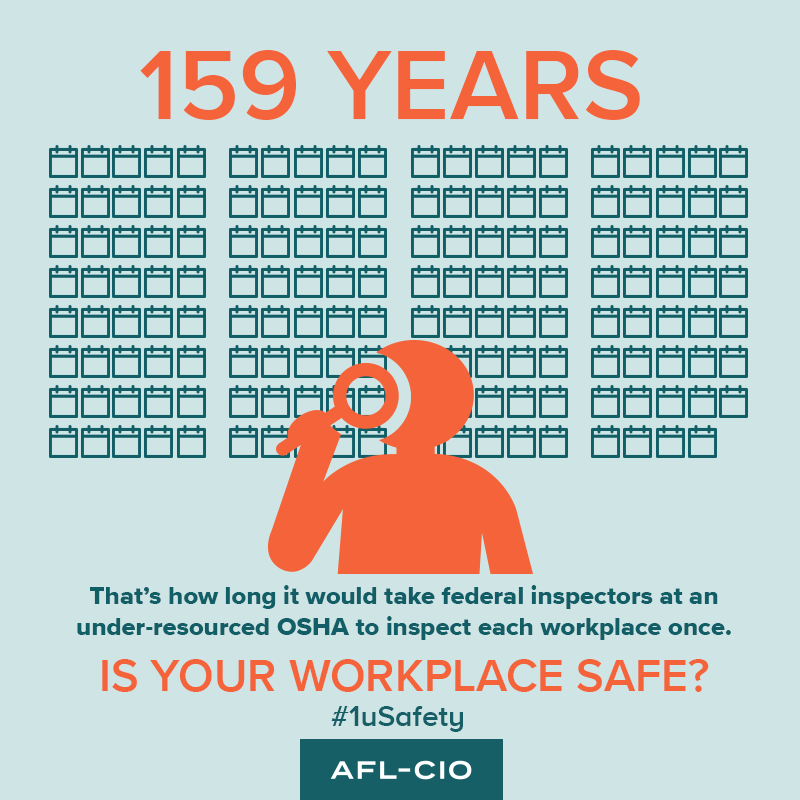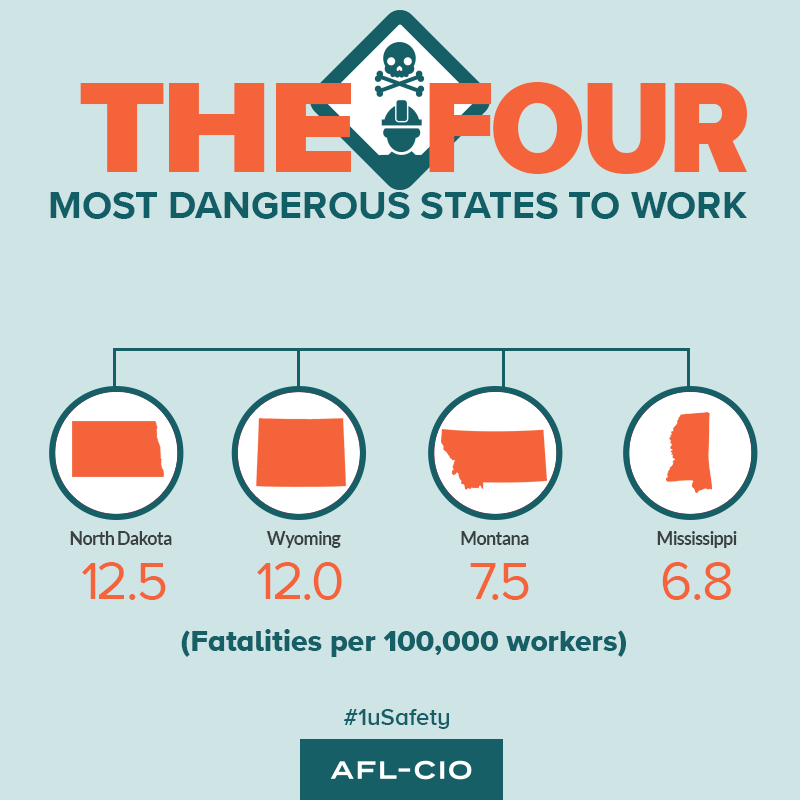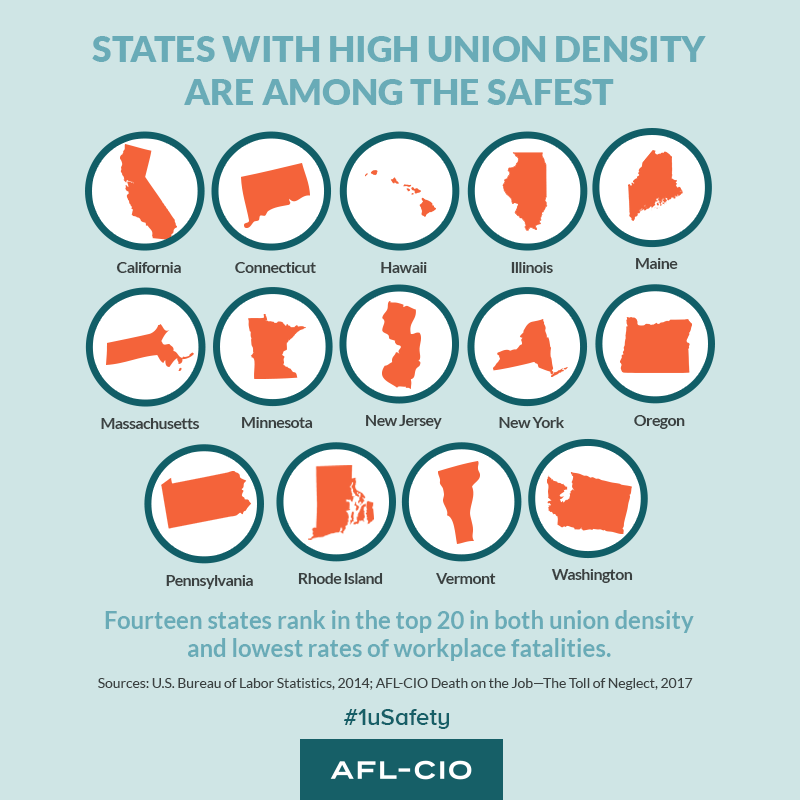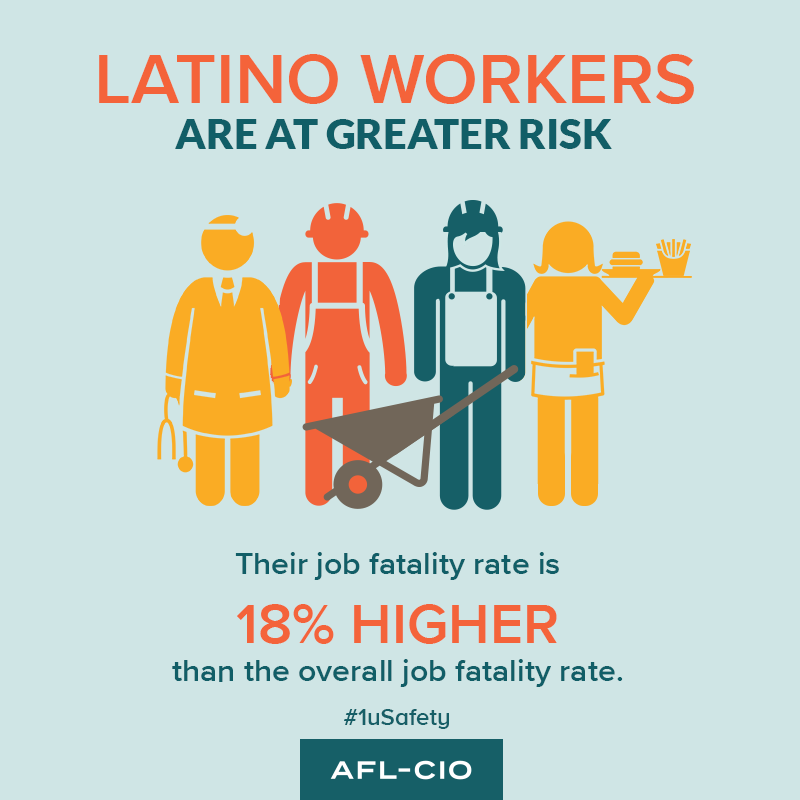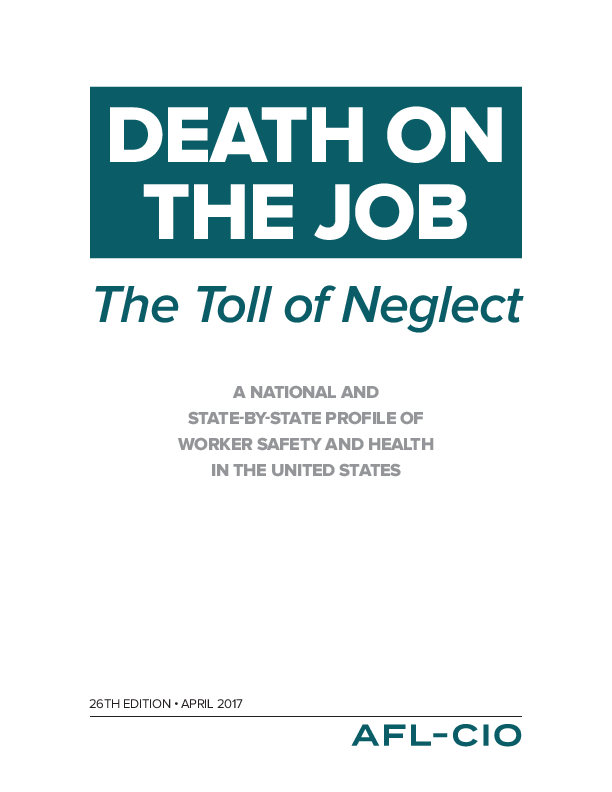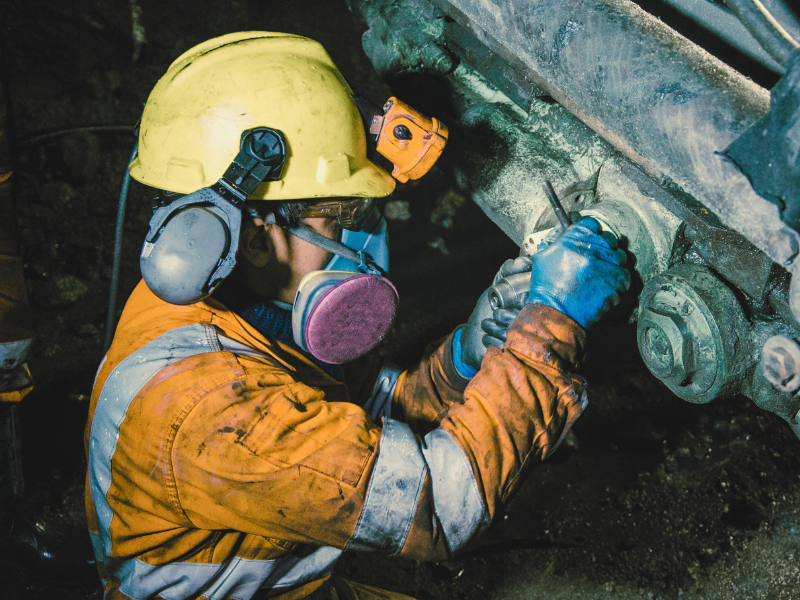This 2017 edition of Death on the Job: The Toll of Neglect marks the 26th year the AFL-CIO has produced a report on the state of safety and health protections for America’s workers.
More than 553,000 workers now can say their lives have been saved since the passage of the Occupational Safety and Health Act of 1970, which promised workers in this country the right to a safe job. The Obama administration had a strong track record on worker safety and health, strengthening enforcement, issuing key safety and health standards, and improving anti-retaliation protections and other rights for workers. With the election of President Trump, the political landscape has shifted dramatically, and many of these gains are threatened. President Trump has moved aggressively on his deregulatory agenda, repealing and delaying worker safety and other rules and proposing deep cuts in the budget, and the elimination of worker safety and health training and other programs.
These are challenging times for working people and their unions, and the prospects for worker safety and health protections are uncertain. What is clear, however, is that the toll of workplace injury, illness and death remains too high, and too many workers remain at serious risk. There is much more work to be done.
The High Toll of Job Injuries, Illnesses and Deaths
In 2015:
- 4,836 workers were killed on the job in the United States.
- The fatal injury rate—3.4 per 100,000 workers—remained the same as the rate in 2014.
- An estimated 50,000 to 60,000 workers died from occupational diseases.
- 150 workers died each day from hazardous working conditions.
- Nearly 3.7 million work-related injuries and illnesses were reported.
- Underreporting is widespread—the true toll is 7.4 million to 11.1 million injuries each year.
States with the highest fatality rates in 2015 were:
- North Dakota (12.5 per 100,000 workers)
- Wyoming (12.0 per 100,000 workers)
- Montana (7.5 per 100,000)
- Mississippi (6.8 per 100,000 workers)
- Arkansas (5.8 per 100,000 workers)
- Louisiana (5.8 per 100,000 workers)
Latino and immigrant workers continue to be at higher risk than other workers:
- The Latino fatality rate was 4.0 per 100,000 workers, 18% higher than the national average.
- Deaths among Latino workers increased significantly in 2015; 903 deaths, compared with 804 in 2014.
- Almost the entire increase in Latino deaths was among immigrant workers; 605 (67%) of Latino workers killed were immigrant workers.
- 943 immigrant workers were killed on the job—the highest since 2007.
Older workers are at high risk. In 2015:
- 35% of all fatalities occurred in workers ages 55 or older, with 1,681 deaths.
- Workers 65 or older have more than 2.5 times the risk of dying on the job as other workers, with a fatality rate of 9.4 per 100,000 workers.
The construction, transportation and agriculture industries (private sector) remain very dangerous:
- 937 construction workers were killed in 2015, the highest number in any sector. The number and rate of construction deaths increased for the second year in a row.
- 765 transportation and warehousing workers were killed in 2015. The fatality rate was 13.8 per 100,000 workers, the second highest of any major industry sector.
- Agriculture, fishing and forestry was the most dangerous industry sector, with a fatality rate of 22.8 per 100,000 workers. 570 workers were killed in these industries.
The mining and extraction industries remain dangerous, but safety and health has improved:
- There were 26 deaths in coal, metal and nonmetal mines in 2016, and 29 deaths in 2015, both record low numbers. The fatality rate in these industries also was at record low.
- There were 89 deaths in oil and gas extraction in 2015, a decrease from 144 deaths in 2014.
- The fatality rate for the overall mining sector, including oil and gas extraction, was 11.4 per 100,000 workers, more than three times the national average.
- Oil and gas extraction industries accounted for 74% of the fatal work injuries in the mining sector.
Workplace violence continued to be a growing problem for workers in 2015:
- 703 worker deaths were caused by violence.
- 417 worker deaths were workplace homicides.
- Violence was responsible for 26,420 lost-time injuries.
- Women workers are at greater risk of violence than men; they suffered 68% of the lost-time injuries related to workplace violence.
The cost of job injuries and illnesses is enormous—estimated at $250 billion to $360 billion a year.
Job Safety Oversight and Enforcement
OSHA resources in FY 2016 still are too few and declining:
- There are only 1,838 inspectors (815 federal and 1,023 state) to inspect the 8 million workplaces under the Occupational Safety and Health Act’s jurisdiction.
- Federal OSHA has enough inspectors to inspect workplaces once every 159 years.
- State OSHA plans have enough inspectors to inspect workplaces once every 99 years.
- There is one inspector for every 76,402 workers.
- The current OSHA budget amounts to $3.65 to protect the safety and health of each worker in America.
OSHA enforcement has gotten stronger, but penalties in FY 2016 still are too weak:
- The average penalty for a serious violation was $2,402 for federal OSHA.
- The average penalty for a serious violation was $1,747 for OSHA state plans.
- The median penalty for killing a worker was $6,500 for federal OSHA.
- The median penalty for killing a worker was $2,500 for OSHA state plans.
- Only 93 worker death cases have been criminally prosecuted under the Occupational Safety and Health Act since 1970.
Regulatory Action
The Obama administration produced a number of significant safety and health rules and left a solid legacy of worker protections in place. While the first term saw many regulatory delays, the second term was much more productive. The administration’s regulatory record includes:
- A final OSHA beryllium standard issued in 2017 to protect workers in general industry, maritime and construction sectors.
- OSHA’s final silica standard, issued in 2016, to reduce dust exposures in general industry, maritime and construction sectors, and protect workers from deadly lung diseases and cancer. The silica rule will prevent more than 600 deaths and 1,000 cases of silicosis each year.
- OSHA’s electronic injury reporting/anti-retaliation rule, issued in 2016, will require employers to report injury data to OSHA and prohibit employers from retaliating against workers who report job injuries.
- MSHA’s final rule issued in 2015 requires proximity detection systems on continuous mining machines in underground coal mines to prevent injuries and deaths from contact with this equipment.
- MSHA’s 2014 coal dust rule reduces dust exposures and protects miners from black lung.
- A number of other rules remain unfinished business, including OSHA rules on combustible dust and infectious disease, and MSHA rules on proximity detection for mobile equipment and silica.
Workers’ Safety and Health Protections are in Danger
The Trump administration and the Republican majority in Congress have launched a major assault on regulatory protections. They have moved aggressively to roll back regulations and block new protections. Agency budgets and programs are on the chopping block. Worker protections are threatened, and workers’ safety and health are in danger. Major actions taken to date with a direct impact on worker safety and health include:
- A presidential memorandum issued on Jan. 20, 2017, directing agencies to freeze the regulatory process and delay the effective date of final rules not yet in effect.
- Executive Order 13771, issued Jan. 24, 2017, requires that for every new regulatory protection issued, two existing safeguards must be repealed.
- Repeal of OSHA’s rule clarifying an employer’s obligation to keep accurate injury and illness records.
- Repeal of a rule that would have required companies to disclose safety and health and labor violations in order to qualify for federal contracts.
- Delay in the effective date of OSHA’s new beryllium standard and delay in the enforcement of OSHA’s silica standard in the construction industry. The delay in the silica rule will allow continued high exposures that will lead to 160 worker deaths.
- Budget proposals to slash the Department of Labor’s budget by 21%, eliminate worker safety and health training programs, eliminate the Chemical Safety Board and cut the job safety research budget by $100 million.
Much Work Remains to Be Done
- Workers need more job safety and health protection, not less.
- New OSHA rules on silica, beryllium and injury reporting/anti-retaliation must be defended and fully implemented.
- Rules on infectious diseases, combustible dust and chemical safety should be completed and issued.
- Workplace violence is a growing and serious threat—particularly to women workers and workers in the health care industry. OSHA must keep its promise to develop a workplace violence standard.
- Funding and staffing at job safety agencies should be increased, not cut.
- The serious safety and health problems faced by Latino, immigrant and aging workers must be given increased attention.
- “Regulatory reform” legislation that would require the repeal of existing rules and make it more difficult, if not impossible, to issue new regulatory safeguards should be opposed and stopped.
- Congress should pass the Protecting America’s Workers Act to extend the Occupational Safety and Health Act’s coverage to workers who are currently excluded, strengthen civil and criminal penalties for violations, enhance antidiscrimination protections, and strengthen the rights of workers, unions and victims.
- The nation must renew its commitment to protect workers from injury, disease and death, and make this protection a high priority.
